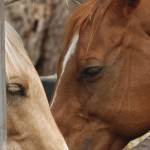Food Allergies in Horses

Little is known about the frequency of adverse food reactions in the horse, though best estimates indicate that such instances are rare. Adverse reactions to feed might go unrecognized completely by caretakers or be corrected before veterinary attention is sought. Because adverse reactions to feed are difficult to rule out, veterinarians may misdiagnose them, attributing signs instead to an insect bite, medication, fly repellant, vaccine, or other cause (all of which can induce dermatological problems).
Feed-related reactions often cause hives or wheals over patches of the horse’s body. In most instances, these raised areas, sometimes called “protein bumps,” cause horses little or no discomfort, though some may wish to rub affected areas to relieve itchiness.
The development of protein bumps has nothing to do with the amount of protein consumed. When brought about by diet, hives represent an allergic reaction to a specific protein contained in the ration. Isolating the offending feedstuff may be difficult, and a veterinarian should be consulted if an adverse food reaction is suspected.
Feedstuffs reported to cause reactions in horses include alfalfa, barley, beet pulp, bran, buckwheat, chicory, clover, oats, St. John’s Wort, wheat, and various feed additives and supplements.








